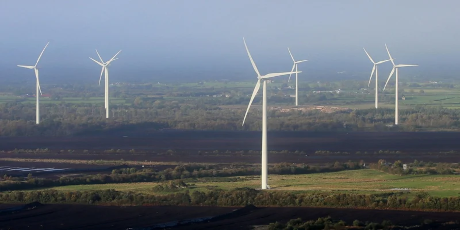How long does energy innovation take? 03 May 2022

Analysis: if past energy innovation has been slow, all future energy innovation must be fast to deal with unprecedented challenges - Dr. Fionn Rogan, Senior Research Fellow, MaREI Centre/ERI, University College Cork
You're a 20-year-old engineering student who has just come up with a brilliant new idea for how to sustainably generate electricity. You decide to dedicate your career to developing and commercialising this new technology. How many years will it take for your technology to achieve full commercialisation, as in 20% of total market capacity?
If you’re like some of the energy engineering students in UCC, you might have initially guessed eight to 10 years for your idea to be fully commercialised. The optimism of youth! Obviously, the true answer is unknown, because the future is so wide open, though research on the duration of historical energy innovation can provide clues.
The path of any successful innovation is a long and winding one, but the many milestones can be broadly grouped into two sets. First, the stages of invention, development and demonstration can be grouped together. For these stages, historical case studies suggest a total average duration for electricity generation technologies of 25 years. Congratulations, your electricity generation technology has been invented, developed into a standard design, demonstrated to work at full-scale, and you are now 45 years old.
Second, the milestones of market deployment, commercialisation and diffusion can be grouped together. Again, there is much historical variation for different technologies, but the average duration to get from first commercially installed unit to 20% of total system capacity is 20 years. For Ireland this checks out: it took 19 years from our first commercially installed wind farm in Mayo (1992) to wind achieving 20% of total electricity capacity (2011).
Adding all the stages together, that’s a total duration of 45 years. At this stage, our one-time 20 year old engineering student will be turning 65 and thinking about retirement. If you’re lucky, you’ll have royalties from a successful invention to top up your pension.
Energy technologies are not just supply-side (such as electricity generation), but are also demand-side for all the energy services of modern life such as transport, heat, light and many more. Compared to supply-side technologies, demand-side technologies tend to be smaller, have shorter life-spans and are less reliant on large infrastructure. For these reasons, they have a quicker innovation life-cycle from idea to full commercialisation. But the total duration still ranges from 25 to 35 years depending on whether the end-use technology is novel (as in, it did not previously exist) or a replacement (an upgrade for an existing technology).
These numbers from the past are not meant to be infallible predictors for the future. Their range is significant, and they vary according to how the start and end points are defined. When defined differently, the durations are sometimes shorter, though more often longer. Despite these caveats, historical studies are useful rules of thumb to guide anticipation about future technology prospects. Since hype frequently accompanies innovation claims, they are an important corrective to excessively optimistic expectations.
Insights from historical case-studies are also useful in highlighting that the stages of invention, development and demonstration - what many think of as innovation - are only half the journey to market diffusion. And market diffusion is where it’s at when it comes to limiting global warming to 1.5 degrees.
Like a rapidly growing number of countries, Ireland has a net-zero emissions target by 2050. This means emissions from sources such as energy and agriculture must be either zero or balanced by sinks, such as forestry or negative emissions technologies, by 2050. Near-term targets for Ireland are particularly ambitious: two sets of five-year carbon budgets that align with a 51% reduction in greenhouse gases by 2030 compared to 2018.
Can Ireland’s energy system achieve these 2030 targets? Energy modelling analysis from UCC has shown that these 2030 targets are achievable with commercially available technologies. It does require, however, early action and rapid technology diffusion across all sectors particularly electricity. We need to moderate levels of energy demand through energy efficiency and behavioural change to make the targets much more feasible.
Can Ireland achieve a net-zero energy system by 2050? Unfortunately, our engineering student (now 48 years old) will struggle to contribute since their sustainable electricity generation technology has just started the market deployment stage, according to historical precedents for technology life-cycles. Fortunately, a substantial part of Ireland’s net-zero target can be achieved by currently available mature technologies, though there is uncertainty for certain sectors and technologies which haven’t yet been fully commercialised.
Given the timelines suggested by historical analysis, it should be clear that hoping an as-yet uninvented technology will help Ireland achieve its 2030 or 2050 climate targets is a risky strategy. Our engineering student thought experiment imagined starting from zero, but there are already thousands of young energy technologies in research centres such as MaREI being developed and refined, tested at different scales, demonstrated at full scale, converted into new uses and trialled in niche markets.
It should be clear that hoping an as-yet uninvented technology will help Ireland achieve its climate targets is a risky strategy
These energy innovations are more important than ever. While the climate policy challenge of translating ambition into implementation shouldn’t be underestimated, the Russian invasion of Ukraine has put an unprecedented spotlight on the need to decarbonise energy as quickly as possible.
Many of the technologies we need to eliminate fossil fuels and achieve net-zero are commercially available or nearly commercially ready. But achieving full market diffusion will need to be happen faster than historical precedents show. Research and insights into how to accelerate this diffusion will be vital. If some past energy innovation has been slow, all future energy innovation must be fast.